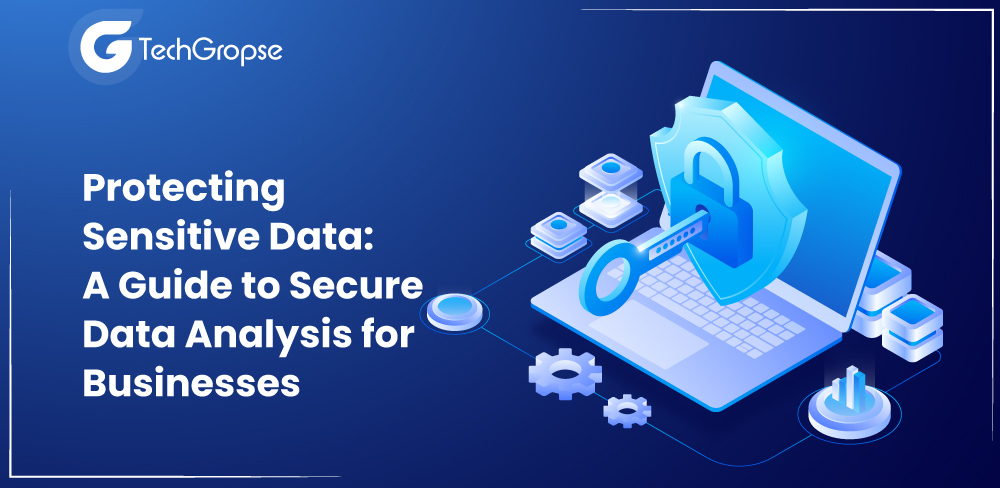It involves using different tools, algorithms, and processes to discover any threats or vulnerabilities in IT systems. It uses different measures to analyse all the security events to see if there are any issues. It can also use other practices like threat intelligence to detect any insider threats that may lead to attacks from external sources.
Companies use secure data analysis processes to examine the user’s behaviour, analyse non-IT data and check the business applications. Having a secure data analysis eradicates the chances of having any cybersecurity attacks. It prevents attacks and provides more information about unusual behaviour that may compromise the business security ecosystem.
Best Practices for Securing Sensitive Data in a Business Environment
There are different practices that businesses can use to secure their sensitive data. It is the role of everyone to ensure the data is safe from unauthorized access. When dealing with cyber threats, there are internal and external threats.
Some of the common practices include:
1. Implement encryption
Encrypt all the business information using the latest algorithms and technologies to prevent unauthorized access. There is a lot of data leakage that happens around businesses. To avoid all this, encrypt all your data sources from the cloud, computers, and mobile devices. SSL certificate is the answer to protect sensitive data in transit. SSL cert secures the data between the server and the browser.
2. Control those who have access to the business property data
Some of the common ways you can implement include
- Limiting those who can have physical entrance to the servers and network system. Ensure you have enough video surveillance around the premises and only allow workers to access some parts of the business data using computers and mobile devices alone.
- Use of identity management, i.e. fingerprints, biometrics, and scans for data access. Ensure password management practices and implement two-factor authentication for all customer accounts.
- Using the least principle privilege, you only provide access to the users when needed and for a specific time.
3. Develop company policies and have proper response plans
Each business should develop its cybersecurity policies, processes, and protocols. It provides a checklist that the employees check to ensure they are met. It also provides more information to the users and stakeholders about your company.
Policies can also have steps for everyone who handles data. It should allow the termination of employees who goes against them. It should also have an outline of patch management and database audits.
In case of a cyberattack, businesses should have a better plan on how they will respond to it, avoid any losses, and get back to business. Other regulations and laws like DPR, HIPAA, and NIST require companies to outline what they can do in case of an attack. It should also outline a data recovery for the same.
4. Educate your users and employees on the importance of securing sensitive data
Create resources to teach your employees and users different ways to protect themselves from hackers and keep sensitive data safe. Teach them how to notice some of the dangerous methods hackers use, like social engineering and phishing and what to do in case of attack. Businesses can pay for some cybersecurity courses and ensure employees take some of the courses.
Your company can use the people-centric approaches where users play an important role in making security measures, and you have higher chances of eliminating threats.
5. Use endpoint security systems
Most threats that happen in business come from endpoints like networks and infrastructure. To have a secure security system, implement the measures below:
- Install an antivirus on the computers, servers, and workstations, and ensure you conduct regular scanning to check for any malware.
- Install Antispyware to remove any spyware that may be installed on your network or infrastructure without the company’s knowledge.
- Install firewalls on your network and servers to provide extra security to your company assets.
6. Monitoring the user’s behaviour
When working with applications, ensure you monitor the user’s behaviour. It will show you any suspicious activities that may happen if a user tries to access any sensitive information.
You can create alerts to get notifications in case of suspicious behaviour, use metadata to record all the sessions, and have a proper incident response in case of any breach.
Tools and Strategies for Protecting Sensitive Information from Unauthorized Access
Businesses have many options when selecting which tools to use for data analysis. Most tools use machine learning and data science to analyse company data. Examples of commonly used tools include:
- Sumo logic. It analyses logs through charts, alerts, graphics, and integrations.
- It provides advanced features that the normal antivirus cannot detect. It ransomware and malware on all devices and is important in providing security for endpoints and good for incident response.
- Cloud monitoring software enables businesses to monitor tier servers, tools, services, and databases easily.
- It is one of the best tools for software teams and business owners. It scans all website pages, applications, and websites to find any vulnerabilities.
- SecPod SanerNow. It monitors the company’s security by checking for vulnerabilities, risks, and misconfiguration. In case of any risk, it fixes them automatically.
- Perimeter 81. It is good for ensuring your network is free from any threats. It improves security using single sign-in and multi-factor authentication. It controls network traffic.
How to Monitor and Audit Your Internal Security Protocols on a Regular Basis
Data security is essential for any business, and ensuring the data is safe and meets all the security protocols is another task. It involves the company putting in more energy by developing processes for monitoring and auditing your protocols to eliminate any chance of having a cyber attack. Some of the ways include:
1. Use of penetration tests
The company can use its penetration teams if they exist or hire an organization that will test different parts of the company infrastructure and find if there are any vulnerabilities.
The company can also use different vulnerability software that scans all the business networks, servers, applications, and computers to see if there is any weakness. The team later prepares a report and recommendations that the business must implement.
2. Use of auditors
Businesses should develop company policies that deal with data security. Businesses should use internal and external auditors to ensure good data security. For internal auditors, you can use workers who have experience in the field. For external auditors, you hire them from organizations like ISO (International Organization for Standardization) and CCPA (California Consumer Privacy Act).
After analysing all your processes and policies, they prepare a report about your security protocols and recommendations. The report is full of charts, tables, findings, dashboards, etc. Your team should later read and analyze the report and take the necessary action.
3. Implement different monitoring methods
Monitoring involves getting all the data and analyzing it based on the company processes and policies and the impact on data security. It provides you with all the alerts in case of abnormalities or vulnerabilities. There are two ways to implement this:
- Automated reviews-it involves using software to automate the monitoring processes. You can use security information and Event Management tools, Database Activity Monitoring, and Data Loss Prevention tools.
- Manual reviews involve inspections, conducting tests, and reviews using manual methods like questionnaires and surveys to understand the business policy and processes.
What Are the Benefits of Using Secure Analytics Software and Services?
Most businesses handle much data from their servers, networks, users and records. Using secure analytics software and tools provides you with the chance to have better security than using the old traditional methods that were insecure and could not fully protect the business. Every business has the chance to benefit from the software and services.
Here are some of the benefits of using secure analytics software and services.
1. Detects security incidents and provide response measures
The software and service collect data from different sources, i.e. networks, users, applications, cloud, audits, management data and intelligence sources. They later use different events and create alerts to detect any vulnerabilities that happen in real-time.
It creates pinpoints and relations between the logs and the data collected from other sources and then provides results.
2. It provides forensic analytics
Forensic analytics provides more details about an attack. It outlines the source of an attack, data loss cases, systems affected, and assets lost. They can provide timelines, making cybersecurity teams easier to protect business assets.
Most of the software and services use big data analytics like statistics and data science to detect any threats in real time. They later provide alerts that can get combined with forensic data on where the threats came from and how to respond.
3. Ensures you meet compliance
Businesses must meet regulations set by different governments and industries to deal with clients’ data. Some of the common regulations include PCI DSS(Payment Card Industry Data Security Standard), General Data Protection Regulation (GDPR), and HIPAA(Health Insurance Portability and Accountability Act). Analytics ensures you meet the regulations.
Using the services enables the company to deal with different data sources, integrate them, and have a better view when the data travels across different sources. It reduces the chances of noncompliance that could lead to fines.
Conclusion
There is an increase in cyber threats due to the high demand for business data. Having vulnerabilities and insecurities around your businesses can cost you a lot quickly. Businesses should have strong and reliable threat detection policies, processes and methods. The tools simplify most of the processes by automating them. The guide above covers implementing tools, benefits and practices when dealing with securin data analysis.









